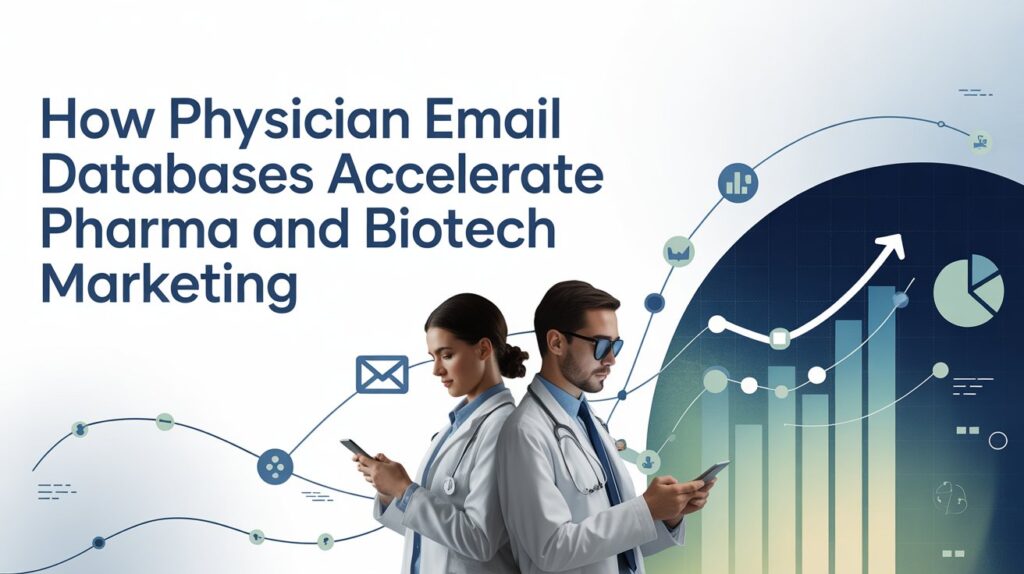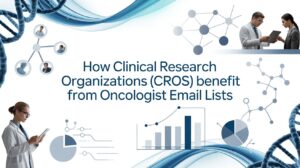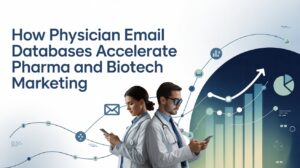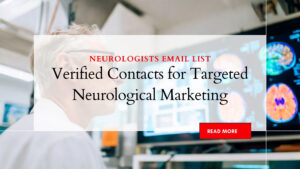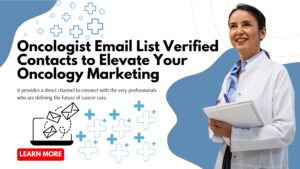Pharma and Biotech Marketing has evolved dramatically in recent years, driven by data, technology, and increasingly complex healthcare regulations. Companies are now expected to deliver precise, compliant, and measurable outcomes across every stage of their marketing, from early-stage clinical trial recruitment to full-scale product launches. Traditional methods relying solely on field sales representatives and medical liaisons are no longer sufficient to meet these demands.
In this landscape, a Physician Email List emerges as a critical tool for life sciences organizations. By leveraging curated and verified contact data, companies can connect with the right specialists, share accurate scientific information, and accelerate both research initiatives and commercial growth in an efficient, scalable, and compliant manner.
1. The Digital Shift in Pharma and Biotech Marketing
The healthcare communication model has undergone a massive transformation over the last decade:
- Physician schedules are more constrained than ever, reducing access for in-person detailing.
- Regulatory bodies such as the FDA, EMA, and local authorities demand greater transparency in promotional activities.
- Digital-first communication is now preferred by physicians, with 72% saying they check work-related emails daily (Accenture, 2024).
- Data analytics tools empower teams to measure engagement, segment audiences, and personalize outreach in real time.
This digital evolution has made data accuracy, segmentation, and personalization the new pillars of successful pharmaceutical and biotech marketing campaigns.
A physician email database is not just a contact repository—it’s a strategic infrastructure that fuels engagement across marketing, medical affairs, and clinical operations.
2. What Exactly Is a Physician Email Database?
A physician email database is a structured and verified collection of healthcare professionals’ information designed for outreach, marketing, and communication.
A typical database contains:
- Full Name and NPI Number
- Specialty and Subspecialty (e.g., cardiology, oncology, neurology)
- Email Address and Contact Number
- Hospital or Clinic Affiliation
- Practice Type (academic, private, government, research-based)
- Geographical Location
- Years of Experience and Licensing Status
- Communication Preferences
Premium datasets may also include:
- Prescribing patterns (for compliant B2B analytics)
- CME participation data
- Professional memberships and affiliations
These data points allow precise segmentation and hyper-personalized campaigns that outperform generic outreach by a significant margin.
3. The Strategic Importance for Pharma and Biotech Companies
Pharmaceutical and biotech marketing is not about volume—it’s about relevance and speed. When you can identify and connect with the right physicians early in the process, you can dramatically accelerate key business outcomes such as:
- Drug awareness and education
- Clinical trial recruitment and site activation
- Key Opinion Leader (KOL) engagement
- Post-market surveillance feedback
- Real-world evidence collection
- Continuing medical education (CME) participation
Below is a comprehensive look at the value chain impact:
Area of Impact | How Physician Databases Add Value | Business Outcome |
Drug Launch Marketing | Target physicians treating specific indications and regions. | Faster awareness, earlier adoption. |
Clinical Trial Operations | Recruit qualified investigators and referring physicians. | Reduced recruitment timelines. |
KOL Identification | Locate influential specialists for thought-leadership roles. | Stronger brand credibility. |
Medical Affairs Communication | Disseminate trial data and safety updates directly. | Transparent, compliant engagement. |
Post-Market Studies | Gather outcomes and feedback from prescribing physicians. | Enhanced pharmacovigilance and data integrity. |
Multi-Channel Campaigns | Integrate email outreach with webinars, social, and CRM workflows. | Cohesive physician experience across touchpoints. |
This ecosystem approach ensures that every interaction is relevant, timely, and traceable.
4. How Physician Email Databases Power Pharma Marketing
Let’s dive deeper into specific applications across the pharmaceutical lifecycle.
4.1. Pre-Launch and Awareness Building
During the pre-launch phase, pharma marketers use physician databases to:
- Send targeted scientific briefings or whitepapers to specialists.
- Announce drug approvals and indications.
- Educate physicians about clinical efficacy and safety data.
- Conduct surveys for market readiness and brand recall.
Targeting oncologists, cardiologists, or neurologists based on indication ensures minimal wastage and faster traction.
4.2. Sales Enablement and Detailing
Email data empowers digital sales reps to complement or replace traditional in-person visits. Automated workflows send follow-up content, dosage charts, and video explainers—delivering consistent education at scale.
4.3. CME and Educational Webinars
Companies leverage databases to invite verified physicians to Continuing Medical Education (CME) sessions. This builds goodwill and drives non-promotional engagement, essential for long-term credibility.
4.4. Feedback and Real-World Insights
Post-launch, companies gather prescriber feedback, case studies, or side-effect reports through email-based forms and surveys, accelerating real-world evidence (RWE) collection.
5. The Role in Biotech Growth and Research Collaboration
For biotech organizations—especially startups and R&D-driven firms—relationship building with clinicians is critical.
5.1. Clinical Trial Recruitment
Biotech trials often focus on rare diseases or specialized therapies, making investigator access crucial. Email databases allow:
- Outreach to specialists treating specific patient cohorts.
- Recruitment for Phase I–IV trials.
- Communication with Institutional Review Boards (IRBs).
5.2. KOL and Research Collaboration
Identifying academic oncologists, immunologists, or geneticists who can act as scientific advisors becomes far easier with segmented physician data. Collaboration accelerates validation and regulatory approval processes.
5.3. Funding and Partnership Visibility
Biotech companies often engage physicians to promote early-stage results or attract investors via data-driven newsletters and publication updates. High-quality email data ensures targeted dissemination.
6. Data Quality: The Core Differentiator
Not all databases are created equal. The accuracy, freshness, and compliance of physician data determine campaign success.
A reliable database should be:
- Regularly Updated: Physician data decays at 30–35% annually as professionals move or change specialties.
- Double-Verified: Emails validated through both human verification and AI tools.
- Permission-Based: Explicit opt-in consent to ensure compliance.
- Rich in Attributes: More than just names—context matters for targeting.
Trusted providers typically refresh their physician datasets every 90 days using NPI registries, state medical boards, and professional network validations.
7. Advanced Segmentation: Precision Targeting in Practice
Segmentation enables tailored content that resonates. Here’s how pharmaceutical teams segment effectively:
- By Specialty and Subspecialty:
Example – Cardiologists for antihypertensives, Oncologists for immunotherapies. - By Practice Type:
Private clinics vs. hospital systems. - By Geography:
To align with local regulatory or reimbursement conditions. - By Prescribing Volume:
Identify high-prescribers (where permitted by law). - By Research Involvement:
Target physicians involved in active clinical trials. - By Engagement Behavior:
Prioritize contacts who frequently open or click emails.
Such granularity enhances personalization, drives better deliverability, and supports higher open and click-through rates—often improving ROI by over 40%.
8. Integration with CRM and Automation Tools
To fully leverage these databases, pharma and biotech firms integrate them with Customer Relationship Management (CRM) and Marketing Automation platforms.
Benefits:
- Unified Contact Records: Track every touchpoint and physician interaction.
- Behavioral Insights: See which physicians engage most with specific content.
- Lead Scoring: Prioritize high-engagement physicians for follow-ups.
- Workflow Automation: Schedule product updates, regulatory notices, and reminders automatically.
- Compliance Management: Automatically log unsubscribes and consent trails.
Popular tools include Salesforce Health Cloud, Veeva CRM, HubSpot, and Eloqua—each capable of linking directly to verified physician data sources.
9. Compliance and Ethical Considerations
Data privacy and ethics are non-negotiable. A compliant database should adhere to:
- GDPR (for EU contacts)
- CAN-SPAM (for US-based emails)
- HIPAA (for health-related information security)
- CCPA (for California-based physicians)
Key Practices:
- Maintain explicit opt-in records.
- Provide easy unsubscribe options.
- Avoid sending promotional content disguised as medical education.
- Audit data flows to ensure security and encryption.
Compliance isn’t just legal protection—it’s also a signal of brand integrity in a sensitive industry.
10. Measuring Success: Metrics That Matter
Tracking outcomes ensures continuous improvement. The most important metrics include:
- Email Deliverability Rate – Aim for 95%+
- Open Rate – Benchmarks around 20–30%
- Click-Through Rate (CTR) – 5–10% for well-segmented campaigns
- Conversion Rate – Percentage of physicians taking desired action (registering, prescribing, referring, etc.)
- Bounce Rate – Should remain below 3% with a verified database
- Opt-Out Rate – Below 1% indicates healthy engagement
These KPIs help refine data hygiene, message relevance, and overall outreach performance.
11. Overcoming Common Challenges
Even with great data, execution can falter. Here’s how to mitigate common pitfalls:
Challenge | Why It Happens | Solution |
Data Decay | Physicians move, retire, or switch institutions. | Quarterly updates and real-time verification. |
Low Engagement | Content lacks relevance or personalization. | Segment and tailor value-based messages. |
Compliance Risks | Non-opt-in or outdated contact records. | Partner with compliant data vendors only. |
Deliverability Issues | Poor sender reputation or high bounce rates. | Use verified domains and authentication (SPF/DKIM). |
Campaign Fatigue | Over-emailing or repetitive messaging. | Implement frequency caps and A/B testing. |
Managing these proactively keeps outreach credible and effective.
12. Emerging Trends in Physician Database Marketing
The future of physician marketing is being shaped by data intelligence, automation, and personalization.
- AI-Powered Personalization:
Algorithms analyze behavioral data to predict which physicians will engage next. - Predictive Analytics:
Forecast physician prescribing potential and engagement likelihood. - Omnichannel Outreach:
Seamless coordination across email, LinkedIn, webinars, and tele-detailing. - Dynamic Data Refresh:
Real-time updates from hospital directories and electronic medical records (EMRs). - Interactive Content:
Embedded videos, surveys, and forms that drive active participation. - Data Security Innovation:
Encryption and blockchain verification to prevent data misuse.
Pharma and biotech companies embracing these technologies will redefine competitive advantage in physician engagement.
13. Case Example: Accelerating Oncology Trial Recruitment
Scenario:
A global biotech firm developing an oncology immunotherapy drug faced slow recruitment rates for Phase II trials.
Action Plan:
- Leveraged a curated database of 25,000 oncologists across the U.S. and Europe.
- Segmented by tumor specialization, academic affiliation, and trial experience.
- Sent personalized email sequences introducing the trial and linking to investigator interest forms.
Outcome:
- 48% open rate and 19% click-through rate within 45 days.
- 600+ qualified investigators expressed interest.
- Recruitment timeline shortened by 3 months.
This demonstrates how physician email data can directly translate to accelerated research and clinical outcomes.
14. The Strategic Advantage
A physician database is not just a marketing tool—it’s a competitive differentiator.
It enables:
- Faster go-to-market timelines
- Improved physician loyalty and awareness
- Enhanced compliance documentation
- Better measurement and optimization loops
In an industry where every month of delay can cost millions in lost opportunity, the ability to engage physicians efficiently is mission-critical.
15. Conclusion
As the pharmaceutical and biotech industries continue to evolve, the demand for accurate, ethical, and data-driven communication with healthcare professionals will only intensify. A verified Physician Email Database enables organizations to build stronger, more responsive networks of medical experts—accelerating everything from clinical trials to commercial success.
It’s no longer about sending bulk messages; it’s about creating meaningful, compliant, and targeted conversations with the right specialists.
For teams serious about operational excellence, compliance, and measurable ROI, investing in a high-quality Physician Mailing List is not just smart marketing—it’s a strategic necessity for sustainable growth in the life sciences ecosystem.

